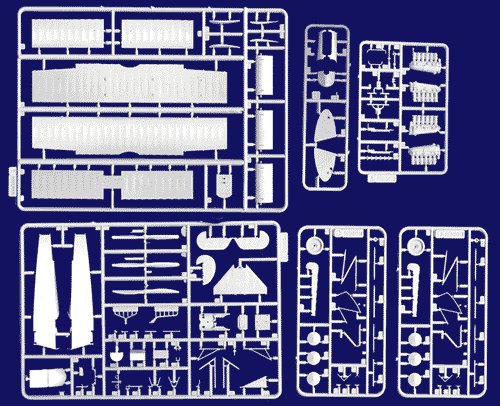
|
KIT: |
Roden 1/48 Fokker D.VII (early) |
|
KIT # |
415 |
|
PRICE: |
$19.98 (17.97 at Squadron) |
|
DECALS: |
Four options |
|
REVIEWER: |
Scott Van Aken |
|
NOTES: |

|
HISTORY |
|
THE KIT |

This is the fourth different manufacturer to produce a 1/48 Fokker D.VII (Ok, purists may say just three). First was Aurora and the kit included a base and a guy to crank over the prop. Next, Monogram bought out Aurora and cleaned up the mold by removing the decal placement marks. It took 20 years before Dragon jumped on the bandwagon and put out what is still a very nice, but equally difficult to find and expensive kit. Now we have Roden to add to that. Many may say that this is just their 1/72 kit Pantographed up to the larger scale, but if you compare it with one of those kits, you'll see that this is an all new molding.
 Typical of Roden's
philosophy, it seems as if several different variants can be built from
this kit as there are two engines, three props, three wheel inserts, and
three landing gear spreader bars. This boxing is for early Fokker built
aircraft as I'm sure that later boxings will have different radiators and
engine side panels to match the different factories from which they were
built. The options on this aircraft are to have an open engine cowling
which requires several extra braces or to simplify things and have that
area closed off. There are also differences in propellers, depending on
the markings that one wants to use. As one should expect from the first
molding of a new kit, this one has no sink areas, but I did find flash on
several large parts, especially on the engine cowling sprue. Fortunately,
that doesn't translate over to the smaller and more finely molded bits. Those few
ejector pin marks are in areas that will basically be invisible once the
kit is finished. I also like the way the fabric was done. While it may
not be flat enough for some people, it definitely is better than the
'hills and valleys' of some older kits.
Typical of Roden's
philosophy, it seems as if several different variants can be built from
this kit as there are two engines, three props, three wheel inserts, and
three landing gear spreader bars. This boxing is for early Fokker built
aircraft as I'm sure that later boxings will have different radiators and
engine side panels to match the different factories from which they were
built. The options on this aircraft are to have an open engine cowling
which requires several extra braces or to simplify things and have that
area closed off. There are also differences in propellers, depending on
the markings that one wants to use. As one should expect from the first
molding of a new kit, this one has no sink areas, but I did find flash on
several large parts, especially on the engine cowling sprue. Fortunately,
that doesn't translate over to the smaller and more finely molded bits. Those few
ejector pin marks are in areas that will basically be invisible once the
kit is finished. I also like the way the fabric was done. While it may
not be flat enough for some people, it definitely is better than the
'hills and valleys' of some older kits.
The instructions are superb and provide full color information with Humbrol and generic references. The D.VII is my kind of WWI aircraft as there is almost no rigging required! Only on the landing gear struts. No mention is made of this in the instructions, but if one has eyes, it can be seen on the box art. Most of us will want to add the control wires as well since the control horns are provided. Decals are provided for the upper and lower five color lozenge and for four aircraft:
The decals are superbly printed and quite glossy, perhaps showing that they've changed the way they do decals. I hope so as my last Roden kit's decals were not the easiest to work with. One thing I would have liked to have seen are pre-cut rib tapes. I doubt if my eyes are good enough to cut the required 0.7mm stripes by hand. Decaling these beasties is time consuming enough without having to prepare dozens of rib tapes.
|
CONCLUSIONS |
I'm sure that this kit will sell well. No longer do people have to pay inflated prices for the old Dragon kit and one does get a lot more detail out of this one. I don't usually do WWI planes, thanks to the rigging, but this one will be headed for the workbench! I'm sure this one will sell out quickly, so if you want one, I'd suggest grabbing it while you can!
You can find this kit and many others at

If you would like your product reviewed fairly and fairly quickly by a site that has over 200,000 visitors a month, please contact me or see other details in the Note to Contributors.